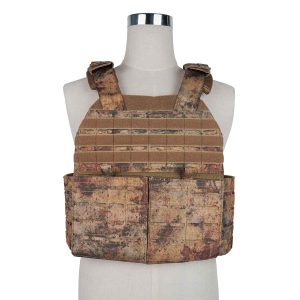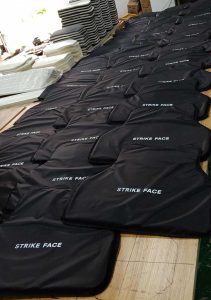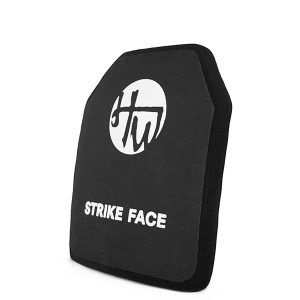Bulletproof vests play a crucial role in personal protection against ballistic threats. These vests significantly reduce the risk of fatal injuries for law enforcement officers, with studies showing that body armor has saved over 3,000 lives in the past three decades. Bulletproof vest performance testing and certification ensure that each vest meets stringent safety standards. Rigorous testing processes evaluate the reliability and effectiveness of bulletproof vests. Ensuring safety and reliability remains paramount in the development and certification of these life-saving tools.

Overview of Bulletproof Vests
Types of Bulletproof Vests
Soft Body Armor

Soft body armor provides protection primarily against handgun bullets. This type of body armor uses materials like Kevlar, which offer flexibility and comfort. Law enforcement officers often prefer soft body armor for daily wear due to its lightweight nature. The soft body armor collection features layers of high tensile strength fibers that absorb and distribute the impact of a bullet.
Hard Body Armor

Hard body armor offers enhanced protection against higher-caliber rounds and rifle bullets. This type of body armor incorporates rigid plates made from materials such as ceramic or Ultra-High-Molecular-Weight Polyethylene (UHMWPE). Tactical soft body armor systems often include hard armor components for use in high-risk situations. Hard body armor provides superior ballistic resistance but tends to be heavier and less flexible than soft body armor.
Materials Used
Kevlar
Kevlar remains one of the most widely used materials in the production of bulletproof vests. This synthetic fiber boasts high tensile strength and excellent impact resistance. Kevlar vests are lighter and more flexible compared to other materials, making them suitable for extended wear. The material’s ability to trap and slow bullets to a complete stop enhances the overall effectiveness of soft body armor.
Ultra-High-Molecular-Weight Polyethylene (UHMWPE)
Ultra-High-Molecular-Weight Polyethylene, also known as UHMWPE, offers a lightweight alternative to traditional body armor materials. This material provides high ballistic resistance while maintaining wearability. UHMWPE is commonly used in both soft and hard body armor systems. The body armor collection includes UHMWPE for its strength and durability, making it a popular choice for various protective applications.
Ceramic Plates
Ceramic plates are integral to hard body armor systems. These plates provide robust protection against high-velocity projectiles. Ceramic materials can shatter upon impact, dissipating the energy of the bullet and preventing penetration. The inclusion of ceramic plates in body armor systems enhances their ability to withstand powerful ballistic threats. Ceramic plates are often used in conjunction with other materials to maximize protection.
Performance Testing Procedures
Ballistic Testing
Testing Standards (NIJ, HOSDB, etc.)
Ballistic standards define the criteria for evaluating body armor performance. The National Institute of Justice (NIJ) sets the most recognized standards in the United States. NIJ standards classify body armor into different levels based on the types of ammunition the armor can stop. The Home Office Scientific Development Branch (HOSDB) provides similar guidelines in the United Kingdom. These standards ensure that body armor meets minimum safety requirements.
European, German, and British standards allow a backface signature of 20-25mm. The NIJ permits up to 44mm. This discrepancy has sparked debates regarding the importance of backface signature versus penetration resistance. A higher backface signature may indicate a greater risk of internal injury, even if the bullet does not penetrate the armor.
Testing Methods (V50, V0, etc.)
Testing methods assess the effectiveness of body armor under controlled conditions. The V50 method measures the velocity at which 50% of bullets penetrate the armor. This metric helps determine the armor’s resistance to specific threats. The V0 method evaluates the maximum velocity at which no bullets penetrate the armor. Both methods provide critical data for understanding the protective capabilities of body armor.
Environmental Testing
Temperature and Humidity Tests
Environmental testing examines how body armor performs under various conditions. Temperature and humidity tests simulate extreme environments to ensure the armor maintains its protective qualities. High temperatures can degrade materials like Kevlar, reducing their effectiveness. Humidity can affect the adhesive properties in multi-layered armor systems. These tests verify that body armor remains reliable in diverse climates.
Water Resistance Tests
Water resistance tests evaluate how well body armor withstands exposure to moisture. Submerging the armor in water for a specified duration assesses its ability to repel water. Wet conditions can compromise the integrity of some materials, leading to reduced ballistic resistance. Ensuring water resistance is crucial for maintaining the armor’s protective capabilities in wet environments.
Durability Testing
Flexibility and Wear Tests
Durability testing focuses on the long-term performance of body armor. Flexibility tests measure how well the armor adapts to movement without compromising protection. Wear tests simulate prolonged use to evaluate the armor’s durability over time. These tests ensure that body armor remains effective throughout its lifespan, even with regular use.
Impact and Trauma Tests
Impact and trauma tests assess the armor’s ability to absorb and distribute force. These tests involve striking the armor with blunt objects to simulate real-world impacts. Evaluating the armor’s response to trauma helps determine its effectiveness in protecting against non-ballistic threats. Ensuring that body armor can withstand both ballistic and blunt force impacts is essential for comprehensive protection.
Certification Process
Certification Bodies
National Institute of Justice (NIJ)
The National Institute of Justice (NIJ) serves as the primary certification body for body armor in the United States. The NIJ sets rigorous standards to ensure that body armor provides adequate protection against ballistic threats. The NIJ Compliance Testing Program evaluates body armor models to verify their compliance with established standards. Approved laboratories conduct these tests, ensuring that each model meets the required specifications. The NIJ certification process involves multiple stages of testing, including ballistic and environmental assessments.
Home Office Scientific Development Branch (HOSDB)
The Home Office Scientific Development Branch (HOSDB) in the United Kingdom also plays a crucial role in certifying body armor. The HOSDB sets standards similar to those of the NIJ, focusing on both ballistic and stab protection. The HOSDB Body Armour Standards ensure that certified body armor can withstand various threats. These standards include specific requirements for waterproofing and durability, ensuring that the armor remains effective in different conditions.
Certification Criteria
Performance Standards
Performance standards form the backbone of the certification process. The NIJ standards classify body armor into different levels based on the types of ammunition the armor can stop. For example, Level III armor must protect against rifle rounds. The NIJ Protection Levels provide a clear framework for evaluating the effectiveness of body armor. The HOSDB standards also include classifications for stab and spike protection. Both organizations ensure that certified armor meets stringent performance criteria.
Compliance and Documentation
Compliance and documentation are essential components of the certification process. Manufacturers must submit detailed documentation to prove that their body armor meets the required standards. The NIJ Compliance Testing Program mandates that manufacturers provide evidence of compliance with all relevant standards. This documentation includes test results, material specifications, and manufacturing processes. The NIJ Testing Information Management system tracks this data to ensure transparency and accountability.
Certification Renewal
Periodic Re-testing
Periodic re-testing ensures that certified body armor maintains its protective capabilities over time. The NIJ certification process requires manufacturers to undergo follow-up inspections and testing at regular intervals. These re-tests verify that the armor continues to meet the established standards. The NIJ FIT test is one such assessment that evaluates the fit and effectiveness of body armor. Regular re-testing helps identify any potential issues and ensures ongoing compliance.
Updates to Standards
Updates to standards reflect advancements in technology and evolving threats. The NIJ certification standards undergo periodic reviews to incorporate new findings and improve safety. The HOSDB also updates its standards to address emerging threats and enhance protection. Manufacturers must stay informed about these updates to ensure that their products remain compliant. Adhering to updated standards guarantees that certified body armor provides the highest level of protection.
Performance testing and certification play a critical role in ensuring the effectiveness of bulletproof vests. Certified armor undergoes rigorous testing to meet established standards, providing reliable protection against ballistic threats. Certified body armor significantly enhances safety for law enforcement officers. Adhering to NIJ standards ensures that armor remains compliant and effective. Regular testing and certification renewals maintain the integrity of certified armor. Certified vests, compliant with NIJ standards, offer the highest level of protection. Ensuring compliance with updated standards guarantees ongoing safety and reliability.
